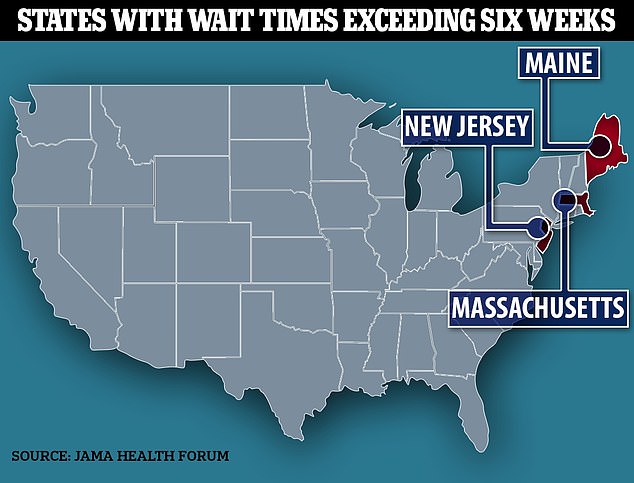Some Americans wait up to two and a half months to receive vital mental health care, including video appointments, a new study has revealed.
Access varies greatly by state, with wait times ranging from five days to three months.
In Maine, patients with conditions such as depression, anxiety and obsessive-compulsive disorder wait up to 10 weeks for an initial appointment.
Meanwhile, in North Carolina, most people wait just four days before speaking to a professional.
Even more worrying is that one in five services the researchers contacted were unreachable, meaning patients would struggle to even ask for help.
Policy analysts at the Rand Corporation think tank surveyed nearly 2,000 mental health clinics across the United States between December 2022 and March 2023 to determine how long a person in each state would typically have to wait for virtual or telephone appointments.
Southern states had the shortest median wait times for virtual mental health care, taking less than two weeks to get an appointment.
Meanwhile, coastal states had longer wait times overall, with people in New Jersey, Massachusetts and Maine having to wait six weeks or more.
The researchers behind the report said higher wait times in certain states could be related to a shortage of qualified mental health providers, policies governing telehealth and varying access to high-speed broadband Internet.
Telehealth has become an integral part of the healthcare landscape in recent years, thanks to the global pandemic, which forced millions of people to turn to online platforms for doctor visits.
Spending on telehealth services increased tremendously between 2019 and 2020, from $306 million to nearly $3.7 billion.
Jonathan Cantor, lead author of the study and policy researcher at the RAND think tank, said: We attempted to replicate the experience of a typical client seeking specialized care at a mental health treatment center in the US.
“The fact that we were unable to locate anyone at one in five centers suggests that many people may have trouble getting to a clinic to ask about mental health care.”
It comes as America’s mental health crisis worsens.
Depression and anxiety among young people doubled as the COVID-19 pandemic dragged on, and overall suicide rates have increased about 30 percent since 2000.
About one-third of adults in the United States currently experience symptoms of depression or anxiety, which is a three-fold increase compared to the prevalence in 2019.
The United States is in the midst of a mental health crisis, with three times as many adults suffering from anxiety or depression compared to 2019

North Carolina had the shortest wait time for a teledoc appointment at just four days. Maine, however, had the longest wait at 75 days.
Most southern states had an average wait time of two weeks or less. Florida and Georgia were the two exceptions with an average wait of more than two to three weeks, while data for Louisiana and South Carolina was not available.
Residents of Missouri, New York and West Virginia will have to wait three to four weeks. Residents of Iowa, Illinois, Wisconsin, Oregon and Connecticut should wait four to six weeks.
And in addition to Maine, residents of New Jersey and Massachusetts have to wait more than six weeks for a teledoc appointment.
Fewer than five clinics in several Midwestern states were surveyed, so no data were provided.
Rural areas have seen a proliferation of telehealth services to address a lack of providers, as most new professionals fresh out of school gravitate toward urban centers where salaries are likely to be better.
Telehealth eliminates the need for patients to travel, offering a more accessible avenue for timely communication with their healthcare providers.
Southern states also have lower population densities than their neighbors north of the Mason-Dixon Line, which translates to fewer people overall seeking mental health care via telehealth.
What’s more, private facilities were almost twice as likely to offer telehealth services compared to those that receive government funding to serve people enrolled in Medicare and Medicaid.
Dr. Cantor said, “Understanding the availability of telehealth is important to inform policies that maximize the potential benefits of telehealth for mental health care.”


